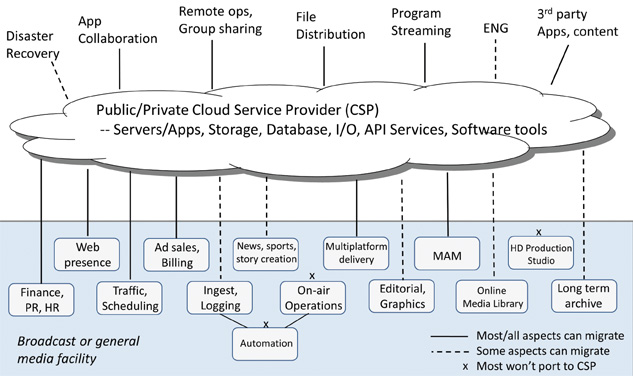A Cloudspotter's Guide to NAB
LAS VEGAS: Let's listen in on a conversation at a media facility. Dave, the GM, is talking with Hal, the Director of Engineering:
"Hal, I hear that the cloud is trending. Do you plan to leverage it?"
"No, Dave, it's too risky. Bandwidth and latency issues will sink us. Plus, we lose infrastructure control and will pay for faster Internet access rates. Nothing is broken, things are working fine."
"Oh, before I forget, the CFO just decided we need to reduce electricity and capital infrastructure costs by 20 percent within two years. What can we do Hal?"
"What! This is serious, Dave. Our systems are not easy to change and we can't control the power they use. Umm, let me have another look at the cloud..."
This conversation is starting to occur at facilities worldwide. Why? It's simple; revenue and profits are always trending. If you have had this exchange or think you will, this piece is for you. Sharp facility engineers and managers are keeping an eye open looking for ways to leverage the cloud. For a quick summary, without commentary, the cloud offers the following values:
- • Tradeoff capex for opex costs
- • Infrastructure agility.
- • On demand trumps forecasting. See the Second Law at cloudonomics.com
- • Significant automation and virtualization advantages
- • Offload power, cooling, floor space, infrastructure maintenance, upgrades, most patching, more
- • Leverage world-class resource utilization efficiency
There are two main cloud types; private and public. The above relates mainly to a public cloud. It is sourced by the likes of Amazon, Google, Verizon, Rackspace, AT&T, Microsoft and alternatives.
On the other hand, a private cloud is captive and may reside at your facility or a regional office. The private cloud does not reap all the benefits of the public so you won't gain maximum leverage. No time here for a complete comparison, but each has its place. This article does not differentiate between the two so a deeper inspection is justified.
Taken together, the listed values offer a gestalt that's hard to beat compared to home-grown solutions. But I know what you are thinking—"Moving a working facility's infrastructure to the cloud is nearly impossible." True, so let's scrap this idea. Rather, look for sweet spots, low hanging fruit to harvest sooner rather than later. Do it as Johnny Cash once sang, "I did it one piece at a time."
CLOUD-FRIENDLY SWEET SPOTS
Fig. 1 identifies some likely paths forward. The lower section outlines a typical broadcast station or generic media facility. Fourteen general work areas are identified. (This is generic so please don't quibble if a domain is missing.) Tagged lines indicate the likelihood of a migration path to the cloud. Importantly, for the most part, the people skills, application functionality and tasks don't change if the cloud is used.

Fig. 1: Facility infrastructure migration to CSP near-term potential For example, some aspects of the news desk and story editing can migrate to the cloud today. Functions such as script writing, proxy A/V editing, logging, rundowns, reporter assignments and similar can execute as a hosted service in the cloud. Why can some work areas migrate, even partially, while others not? Primarily, it's related to performance. Namely, it's the metrics of access "bandwidth," low-latency and deterministic timing. For some media operations, these are blocking specs for any cloud migration. The cloud is not "frame accurate," so the heart and soul of a many facilities, on-air ops, won't be migrating any time soon.
So, based on existing vendor products or the potential of such, the diagram outlines what is likely in 2012. The figure assumes; (1) application execution and storage in the cloud, (2) 3-5 Mbps rates per client and (3) < 75 Ms round trip latency from facility to cloud. Higher client rates and precise timing are best left to local means for the near term.
One hot area is browser-based apps, or web apps, (i.e. Google Docs). Today, most user applications are desktop installable, tied to a device, but this is quickly becoming out of fashion. An application (script writing, logging, searching, proxy editing), that runs in a web browser creates new possibilities for flexible work location and client station types. (For more info see the SMPTE Imaging Journal, "The Landscape of Media Application Deployment," Al Kovalick, March 2012.)
In general, there are two types of web apps. One is SaaS based, (Software as a Service). Here the app is executed in a cloud and accessible from any browser given sufficient access data rates. The application service provider often charges by year per end-user client. Important to the end-user, the application should appear to run local even though it may execute 2,000 miles away. The Gartner Group predicts that SaaS sales will be $21 billion in 2015 with thousand's of SaaS apps to choose from.
The other model is a facility-based web app. You own it, typically. The app is installed in your local data center (runs on a server). In this case, there is no cloud involved but most apps could, in theory, be migrated there. Plan for this.
SHARPENING YOUR CLOUD GAZE AT NAB
So, as you plan your NAB Show itinerary, consider the following:
- • SaaS and software provider based web applications. This aims for the future.
- • Holistic solutions for file transfer, archiving, transcoding, and multiplatform distribution to reach mobile devices and other end points
- • Check the required client connectivity; per-client rates and latency sensitivity
- • How to share resources and content with partners
- • Cloud-attached devices (storage, accelerators, media I/O)
- • Ask vendors what their cloud and web app strategy is. Do this 30 times and you will see the big picture.
- • Visit the "Cloud Computing Pavilion" on the show floor. Consider attending the "Cloud Computing Conference" on Monday, April 16.
You should also be interested in service reliability (up time), security policy, single sign-on, billing, reporting, support, vendor lock-in and vendor stability. Your confidence will build in vendors who are quick to demo what they do in these areas. Slideware only does not count. Happy cloudspotting!
Al Kovalick is the founder of Media Systems Consulting and author of "Video Systems in an IT Environment (Second Edition)". For a complete bio and contact info see www.theAVITbook.com.
The professional video industry's #1 source for news, trends and product and tech information. Sign up below.

